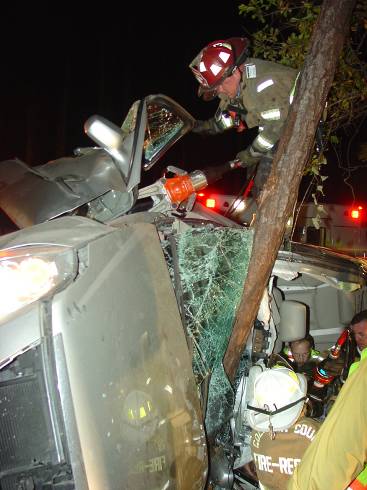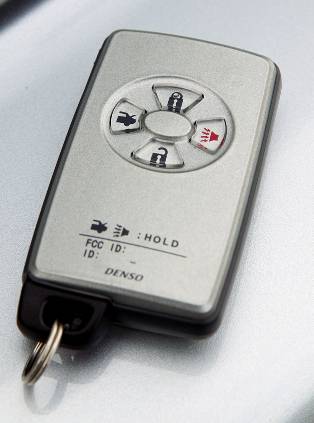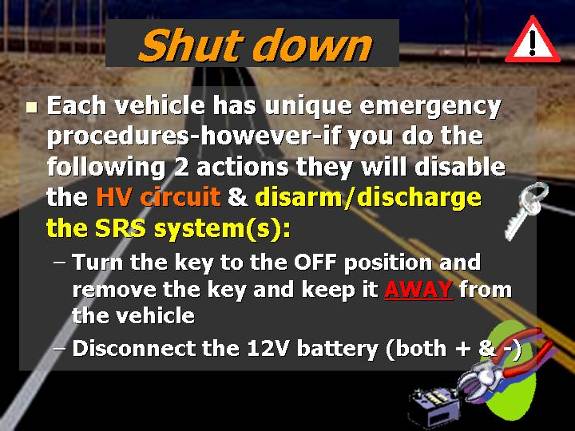
By Dave Dalrymple
For any vehicle we come across on the extrication scene, firefighters must ensure that the vehicle’s power is shut down and remove the keys as soon as possible–regardless of make or model. Power is not the rescuer’s friend, but we interact with it more and more these days. Modern vehicles have numerous power accessories (i.e., power seats, windows, hatches, sliders), and we must consider them in our size-up and management of the patient.


First things first: the keys. Besides “normal” ignition keys, today’s vehicles may have proximity (wireless) keys, which must be kept more than 15 feet from the vehicle so it can’t be accidentally started. After locating and removing the keys, disconnect the 12-V battery. Depending on the vehicle, the battery (or batteries) may be hard to find. More than 40 percent of vehicle batteries are outside the engine compartment, often in the vehicle’s trunk or rear area. Plus, even if the battery is in the engine compartment, it still may be hard to find.
Although each vehicle has unique emergency procedures, the following two actions will disable the high-voltage (HV) circuit and disarm or discharge the supplemental restraint system (SRS):
1) Turn the key to the off position, remove the key, and keep it away from the vehicle–preferably at least 15 feet away (in the apparatus is a good place to keep it).
2) Disconnect or sever the primary 12-V battery, both positive (+) and negative (-) cables.

We must ensure that the vehicle’s power is secured for two important reasons: First, by shutting down the power, we start the process of draining the energy storage component of the SRS computer. This helps ensure that air bags and other SRS features don’t deploy unexpectedly. Second, this shuts down the high-voltage drive power in a hybrid and/or alternative-fuel vehicle.
However, prior to shutting down all power, we need to see what power accessories, such as windows and seats, are in the vehicle. We may need to interact with them first, since trying to adjust most power accessories will be nearly impossible once power is shut down.
The officer in charge should document when power was shut down and what power accessories were identified in the vehicle. We’re dealing with vehicles that have more electrical systems and power sources than ever before. (Note: Navigation aids and theft-deterrent systems can have their own power sources.) And even though we still have to deal with storage capacitors and most of these drain rapidly, there are more of them in modern vehicles, and we still need to work as fast as possible. In addition to the vehicle’s power sources, our tools can cause static charges; we must, therefore, be extremely vigilant. Once the key(s) have been secured, make sure they are placed in your apparatus. As noted, we need to keep keys, regardless of what they are for, at least 15 feet away from the vehicle as a rule of thumb and to build good operational habits. A good concept is to think of power isolation as vehicle “lock out/tagout.”

In the past, many have felt that it wasn’t important to isolate the vehicle’s power, but we need to change our way of thinking to include these tactics. Including power isolation factors into our safety plan protects patients and rescuers alike.
Key things to remember are the following:
- In more than 45 percent of vehicles today, the primary 12v battery lives outside the engine compartment.
- Many vehicles can have more than one 12v battery.
- More than 50 percent of vehicles today have wireless/proximity keys.
- Many batteries are not easily seen or accessible.
- Batteries can literally be anywhere in the vehicle, and secondary batteries do not always look like automotive batteries.
Remember, however, that, depending on vehicle damage and battery location, we might not be able to access the battery or batteries. At the very least, try to access the keys and remove the key from the vehicle.
DAVID DALRYMPLE is a career EMS provider for the RWJUH Emergency Medical Services in New Brunswick, New Jersey, and a volunteer firefighter/EMT/rescue technician for Clinton (NJ) EMS/Rescue. He has been actively involved with emergency services for 27 years. He is the education chair of the Transportation Emergency Rescue Committee-US (TERC), is a certified international level extrication assessor, and serves on the Expert Technical Advisory Board of the IETRI as their road traffic accident advisor. Certified as a NJ fire service instructor, he has been teaching transportation rescue topics for more than 16 years. He is the executive educator for Roadway Rescue LLC, an educational team for transportation rescue training. He is an ICET (Netherlands) certified registered International SAVER instructor. He writes on “Extrication Tactics“ for Fire Engineering and contributed to Fire Engineering‘s Handbook for Firefighter I and II (2009). He received the 2007 Harvey Grant award for excellence in rescue education. He is featured in “Training Minutes“ on vehicle extrication on fireengineering.com.


